Food Processing Techniques & Effects on the Quality of Nutrients
VerifiedAdded on 2023/06/11
|30
|9724
|83
Report
AI Summary
This report provides a comprehensive analysis of the effects of thermal and non-thermal food processing methods on the nutritional quality of food. It begins by defining food processing and differentiating between thermal and non-thermal techniques, highlighting their respective impacts on food safety and preservation. The report identifies key food ingredients like proteins, carbohydrates, fats, fiber, and phenolics, and examines how thermal processing (including blanching, pasteurization, and sterilization) and non-thermal processing (such as high-pressure processing and irradiation) affect their nutritional value. Specifically, it discusses the Maillard reaction, protein glycation, and the formation of toxic compounds like lysinoalanine. The report further explores how each key ingredient contributes to overall nutritional quality and the potential health consequences of deficiencies in these nutrients, including protein deficiency, carbohydrate deficiency, fat deficiency, fiber deficiency, and phenolic deficiency. The study concludes by emphasizing the importance of understanding these impacts to optimize food processing techniques for maintaining nutritional value while ensuring food safety.
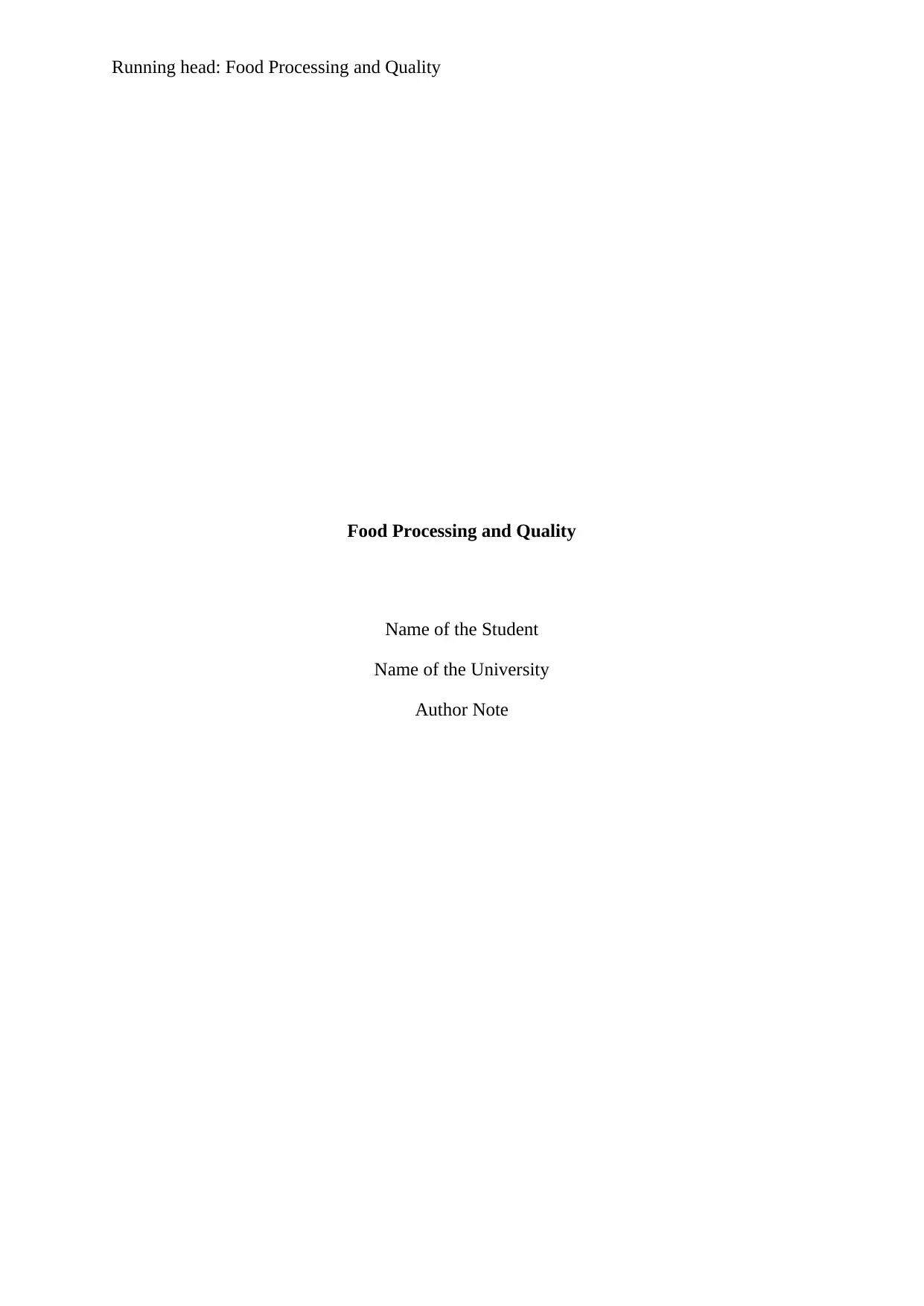
Running head: Food Processing and Quality
Food Processing and Quality
Name of the Student
Name of the University
Author Note
Food Processing and Quality
Name of the Student
Name of the University
Author Note
Paraphrase This Document
Need a fresh take? Get an instant paraphrase of this document with our AI Paraphraser

1Food Processing and Quality
Contents
Introduction:...............................................................................................................................2
What is food processing?.......................................................................................................2
What is thermal and non thermal food processing?...............................................................2
What are the important ingredients of food that affect its nutritional quality?......................3
Effect of thermal and non thermal food processing on the nutritional quality of food
ingredients such as proteins, carbohydrates, fats, fibre and phenolics:.....................................4
Effect of Thermal Processing.................................................................................................4
Effect of Non Thermal Processing.........................................................................................7
Effect of important food ingredients on the nutrient quality of food:......................................11
Protein:.................................................................................................................................11
Carbohydrate:.......................................................................................................................11
Fat:........................................................................................................................................12
Fibre:....................................................................................................................................13
Phenolics:.............................................................................................................................13
Diseases that can occur due to the absence of these ingredients in food:................................14
Protein Deficiency................................................................................................................14
Carbohydrate Deficiency:....................................................................................................15
Fat Deficiency:.....................................................................................................................15
Fibre Deficiency:..................................................................................................................16
Phenolics Deficiency:...........................................................................................................17
Conclusion:..............................................................................................................................17
Contents
Introduction:...............................................................................................................................2
What is food processing?.......................................................................................................2
What is thermal and non thermal food processing?...............................................................2
What are the important ingredients of food that affect its nutritional quality?......................3
Effect of thermal and non thermal food processing on the nutritional quality of food
ingredients such as proteins, carbohydrates, fats, fibre and phenolics:.....................................4
Effect of Thermal Processing.................................................................................................4
Effect of Non Thermal Processing.........................................................................................7
Effect of important food ingredients on the nutrient quality of food:......................................11
Protein:.................................................................................................................................11
Carbohydrate:.......................................................................................................................11
Fat:........................................................................................................................................12
Fibre:....................................................................................................................................13
Phenolics:.............................................................................................................................13
Diseases that can occur due to the absence of these ingredients in food:................................14
Protein Deficiency................................................................................................................14
Carbohydrate Deficiency:....................................................................................................15
Fat Deficiency:.....................................................................................................................15
Fibre Deficiency:..................................................................................................................16
Phenolics Deficiency:...........................................................................................................17
Conclusion:..............................................................................................................................17

2Food Processing and Quality
References:...............................................................................................................................20
References:...............................................................................................................................20
⊘ This is a preview!⊘
Do you want full access?
Subscribe today to unlock all pages.

Trusted by 1+ million students worldwide
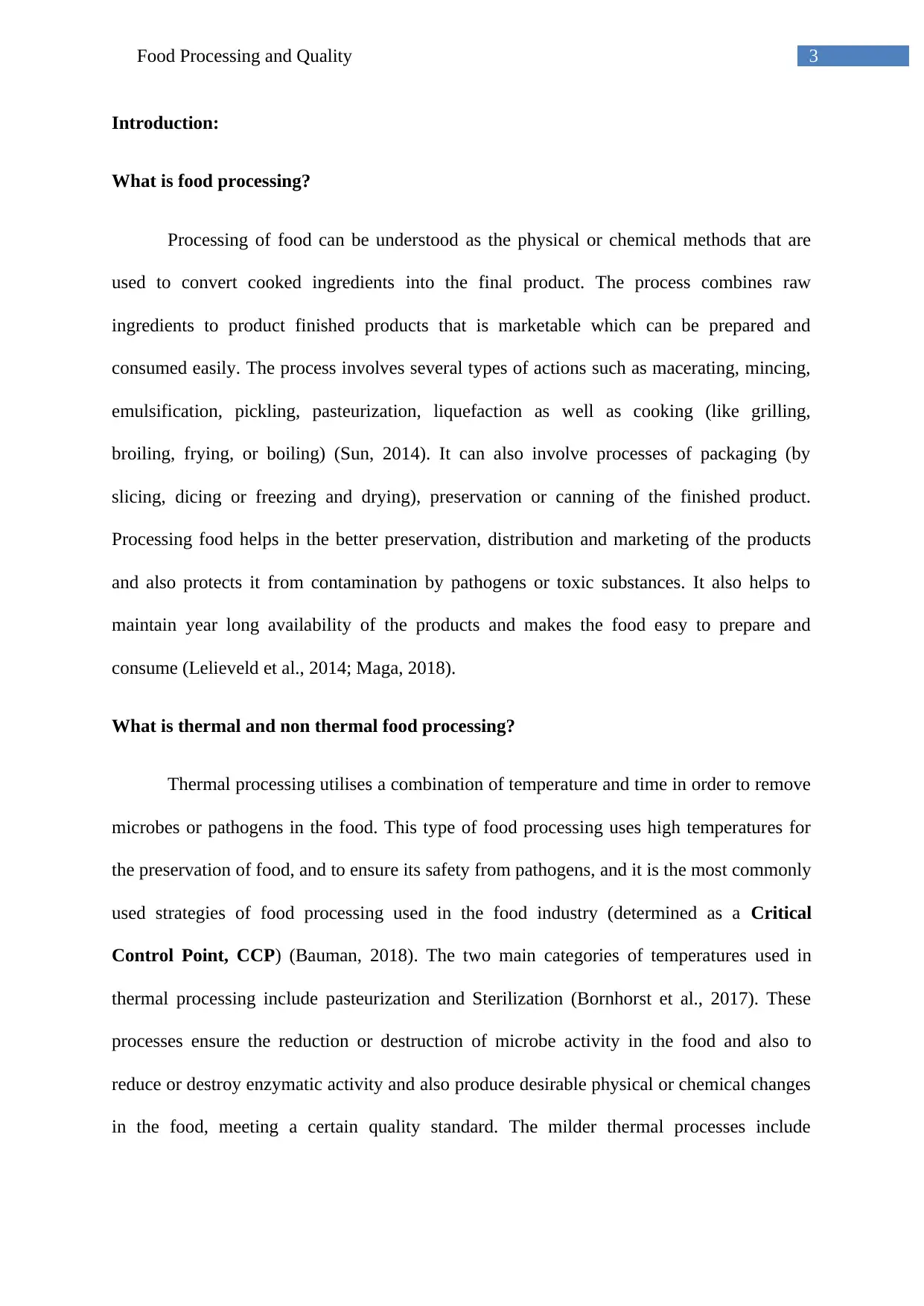
3Food Processing and Quality
Introduction:
What is food processing?
Processing of food can be understood as the physical or chemical methods that are
used to convert cooked ingredients into the final product. The process combines raw
ingredients to product finished products that is marketable which can be prepared and
consumed easily. The process involves several types of actions such as macerating, mincing,
emulsification, pickling, pasteurization, liquefaction as well as cooking (like grilling,
broiling, frying, or boiling) (Sun, 2014). It can also involve processes of packaging (by
slicing, dicing or freezing and drying), preservation or canning of the finished product.
Processing food helps in the better preservation, distribution and marketing of the products
and also protects it from contamination by pathogens or toxic substances. It also helps to
maintain year long availability of the products and makes the food easy to prepare and
consume (Lelieveld et al., 2014; Maga, 2018).
What is thermal and non thermal food processing?
Thermal processing utilises a combination of temperature and time in order to remove
microbes or pathogens in the food. This type of food processing uses high temperatures for
the preservation of food, and to ensure its safety from pathogens, and it is the most commonly
used strategies of food processing used in the food industry (determined as a Critical
Control Point, CCP) (Bauman, 2018). The two main categories of temperatures used in
thermal processing include pasteurization and Sterilization (Bornhorst et al., 2017). These
processes ensure the reduction or destruction of microbe activity in the food and also to
reduce or destroy enzymatic activity and also produce desirable physical or chemical changes
in the food, meeting a certain quality standard. The milder thermal processes include
Introduction:
What is food processing?
Processing of food can be understood as the physical or chemical methods that are
used to convert cooked ingredients into the final product. The process combines raw
ingredients to product finished products that is marketable which can be prepared and
consumed easily. The process involves several types of actions such as macerating, mincing,
emulsification, pickling, pasteurization, liquefaction as well as cooking (like grilling,
broiling, frying, or boiling) (Sun, 2014). It can also involve processes of packaging (by
slicing, dicing or freezing and drying), preservation or canning of the finished product.
Processing food helps in the better preservation, distribution and marketing of the products
and also protects it from contamination by pathogens or toxic substances. It also helps to
maintain year long availability of the products and makes the food easy to prepare and
consume (Lelieveld et al., 2014; Maga, 2018).
What is thermal and non thermal food processing?
Thermal processing utilises a combination of temperature and time in order to remove
microbes or pathogens in the food. This type of food processing uses high temperatures for
the preservation of food, and to ensure its safety from pathogens, and it is the most commonly
used strategies of food processing used in the food industry (determined as a Critical
Control Point, CCP) (Bauman, 2018). The two main categories of temperatures used in
thermal processing include pasteurization and Sterilization (Bornhorst et al., 2017). These
processes ensure the reduction or destruction of microbe activity in the food and also to
reduce or destroy enzymatic activity and also produce desirable physical or chemical changes
in the food, meeting a certain quality standard. The milder thermal processes include
Paraphrase This Document
Need a fresh take? Get an instant paraphrase of this document with our AI Paraphraser
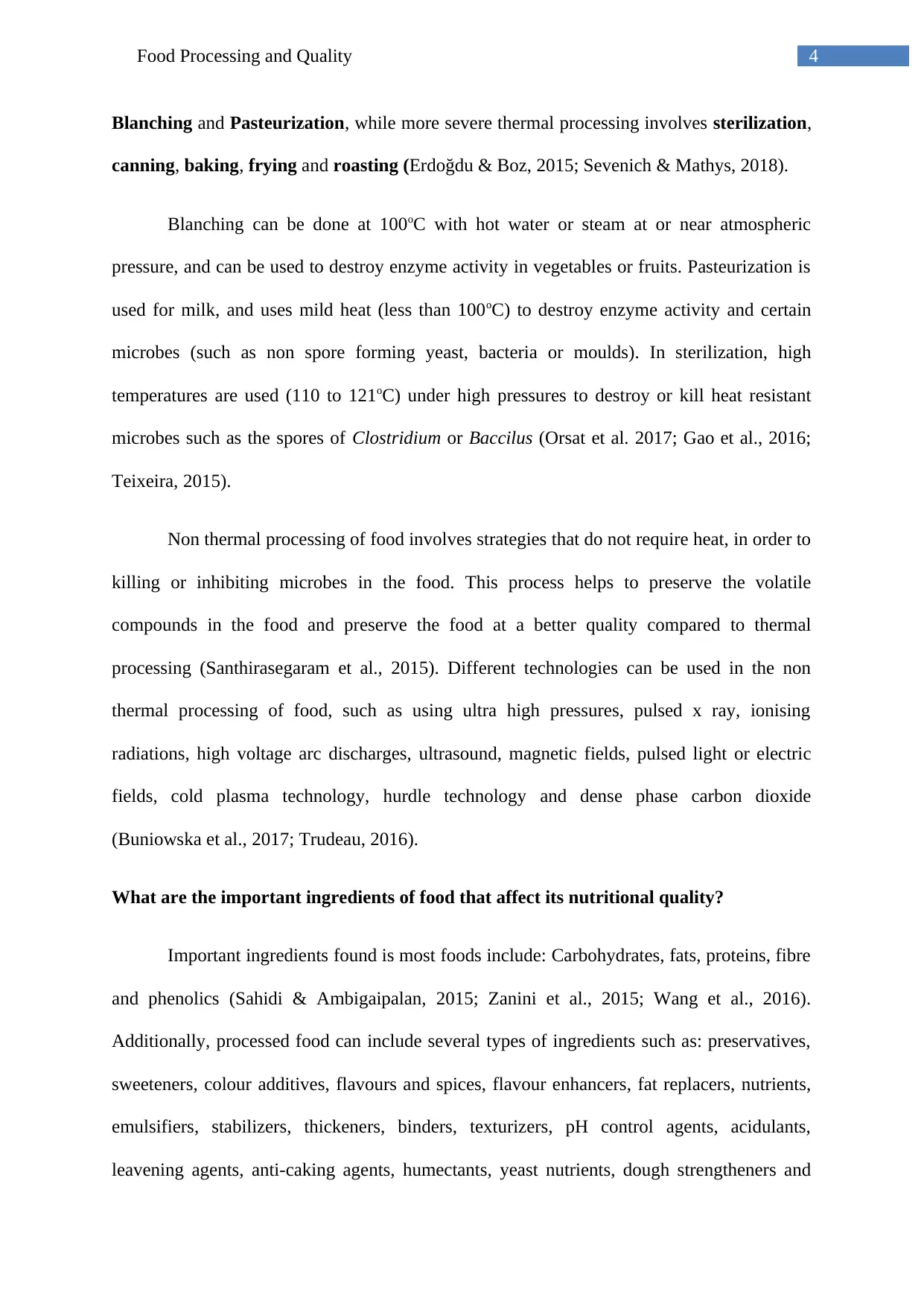
4Food Processing and Quality
Blanching and Pasteurization, while more severe thermal processing involves sterilization,
canning, baking, frying and roasting (Erdoğdu & Boz, 2015; Sevenich & Mathys, 2018).
Blanching can be done at 100oC with hot water or steam at or near atmospheric
pressure, and can be used to destroy enzyme activity in vegetables or fruits. Pasteurization is
used for milk, and uses mild heat (less than 100oC) to destroy enzyme activity and certain
microbes (such as non spore forming yeast, bacteria or moulds). In sterilization, high
temperatures are used (110 to 121oC) under high pressures to destroy or kill heat resistant
microbes such as the spores of Clostridium or Baccilus (Orsat et al. 2017; Gao et al., 2016;
Teixeira, 2015).
Non thermal processing of food involves strategies that do not require heat, in order to
killing or inhibiting microbes in the food. This process helps to preserve the volatile
compounds in the food and preserve the food at a better quality compared to thermal
processing (Santhirasegaram et al., 2015). Different technologies can be used in the non
thermal processing of food, such as using ultra high pressures, pulsed x ray, ionising
radiations, high voltage arc discharges, ultrasound, magnetic fields, pulsed light or electric
fields, cold plasma technology, hurdle technology and dense phase carbon dioxide
(Buniowska et al., 2017; Trudeau, 2016).
What are the important ingredients of food that affect its nutritional quality?
Important ingredients found is most foods include: Carbohydrates, fats, proteins, fibre
and phenolics (Sahidi & Ambigaipalan, 2015; Zanini et al., 2015; Wang et al., 2016).
Additionally, processed food can include several types of ingredients such as: preservatives,
sweeteners, colour additives, flavours and spices, flavour enhancers, fat replacers, nutrients,
emulsifiers, stabilizers, thickeners, binders, texturizers, pH control agents, acidulants,
leavening agents, anti-caking agents, humectants, yeast nutrients, dough strengtheners and
Blanching and Pasteurization, while more severe thermal processing involves sterilization,
canning, baking, frying and roasting (Erdoğdu & Boz, 2015; Sevenich & Mathys, 2018).
Blanching can be done at 100oC with hot water or steam at or near atmospheric
pressure, and can be used to destroy enzyme activity in vegetables or fruits. Pasteurization is
used for milk, and uses mild heat (less than 100oC) to destroy enzyme activity and certain
microbes (such as non spore forming yeast, bacteria or moulds). In sterilization, high
temperatures are used (110 to 121oC) under high pressures to destroy or kill heat resistant
microbes such as the spores of Clostridium or Baccilus (Orsat et al. 2017; Gao et al., 2016;
Teixeira, 2015).
Non thermal processing of food involves strategies that do not require heat, in order to
killing or inhibiting microbes in the food. This process helps to preserve the volatile
compounds in the food and preserve the food at a better quality compared to thermal
processing (Santhirasegaram et al., 2015). Different technologies can be used in the non
thermal processing of food, such as using ultra high pressures, pulsed x ray, ionising
radiations, high voltage arc discharges, ultrasound, magnetic fields, pulsed light or electric
fields, cold plasma technology, hurdle technology and dense phase carbon dioxide
(Buniowska et al., 2017; Trudeau, 2016).
What are the important ingredients of food that affect its nutritional quality?
Important ingredients found is most foods include: Carbohydrates, fats, proteins, fibre
and phenolics (Sahidi & Ambigaipalan, 2015; Zanini et al., 2015; Wang et al., 2016).
Additionally, processed food can include several types of ingredients such as: preservatives,
sweeteners, colour additives, flavours and spices, flavour enhancers, fat replacers, nutrients,
emulsifiers, stabilizers, thickeners, binders, texturizers, pH control agents, acidulants,
leavening agents, anti-caking agents, humectants, yeast nutrients, dough strengtheners and

5Food Processing and Quality
conditioners, firming agents, enzyme preparations and gases. These ingredients help to
maintain and improve the safety and freshness, nutritional value, taste, texture as well as
appearance of the food, and also to improve the shelf life of the food product (Fletcher, 2014;
Elizabeth et al., 2017).
Effect of thermal and non thermal food processing on the nutritional quality of food
ingredients such as proteins, carbohydrates, fats, fibre and phenolics:
Nutritional quality of food as well as its safety is affected by the destruction of
essential amino acids, interactions with various ions of metals, a reduced digestibility of the
food, inhibition of proteolytic and glycolytic enzymes and the production of toxic or anti
nutritional compounds in the food (Chiang & Quek, 2017). The Millard Reaction or
Enzymatic Browning is a significant process that involves the interaction of amino acids,
proteins and peptides with vitamin C and reducing sugars (Abdel-Razek et al., 2017).
Effect of Thermal Processing
The glycation of protein by sugars caused by Thermal Processing can negatively
affect the nutritional value of proteins. The bioavailability of the proteins is reduced by the
cross linkages formed and the destruction of reactive amino acids such as lysine. The loss in
the nutritional quality can be associated with the reduction in nitrogen digestibility due to
impaired absorption from the intestine for heat treated casein, casein-starch and casein-
glucose, thus showing an overall reduction in digestibility of these proteins (Milkovska-
Stamenova et al., 2017; Renzone et al., 2015). It has also been proposed that the reduction in
the intestinal absorption of the lysine derivatives induced by the Millard Reaction is the basis
of the reduction of the nutrient value of food after thermal processing. Also, apart from the
physiological changes to the properties of the non enzymatic Millard’s Reaction Products,
thermal treatment of food can also cause the formation of toxic products such as
conditioners, firming agents, enzyme preparations and gases. These ingredients help to
maintain and improve the safety and freshness, nutritional value, taste, texture as well as
appearance of the food, and also to improve the shelf life of the food product (Fletcher, 2014;
Elizabeth et al., 2017).
Effect of thermal and non thermal food processing on the nutritional quality of food
ingredients such as proteins, carbohydrates, fats, fibre and phenolics:
Nutritional quality of food as well as its safety is affected by the destruction of
essential amino acids, interactions with various ions of metals, a reduced digestibility of the
food, inhibition of proteolytic and glycolytic enzymes and the production of toxic or anti
nutritional compounds in the food (Chiang & Quek, 2017). The Millard Reaction or
Enzymatic Browning is a significant process that involves the interaction of amino acids,
proteins and peptides with vitamin C and reducing sugars (Abdel-Razek et al., 2017).
Effect of Thermal Processing
The glycation of protein by sugars caused by Thermal Processing can negatively
affect the nutritional value of proteins. The bioavailability of the proteins is reduced by the
cross linkages formed and the destruction of reactive amino acids such as lysine. The loss in
the nutritional quality can be associated with the reduction in nitrogen digestibility due to
impaired absorption from the intestine for heat treated casein, casein-starch and casein-
glucose, thus showing an overall reduction in digestibility of these proteins (Milkovska-
Stamenova et al., 2017; Renzone et al., 2015). It has also been proposed that the reduction in
the intestinal absorption of the lysine derivatives induced by the Millard Reaction is the basis
of the reduction of the nutrient value of food after thermal processing. Also, apart from the
physiological changes to the properties of the non enzymatic Millard’s Reaction Products,
thermal treatment of food can also cause the formation of toxic products such as
⊘ This is a preview!⊘
Do you want full access?
Subscribe today to unlock all pages.

Trusted by 1+ million students worldwide
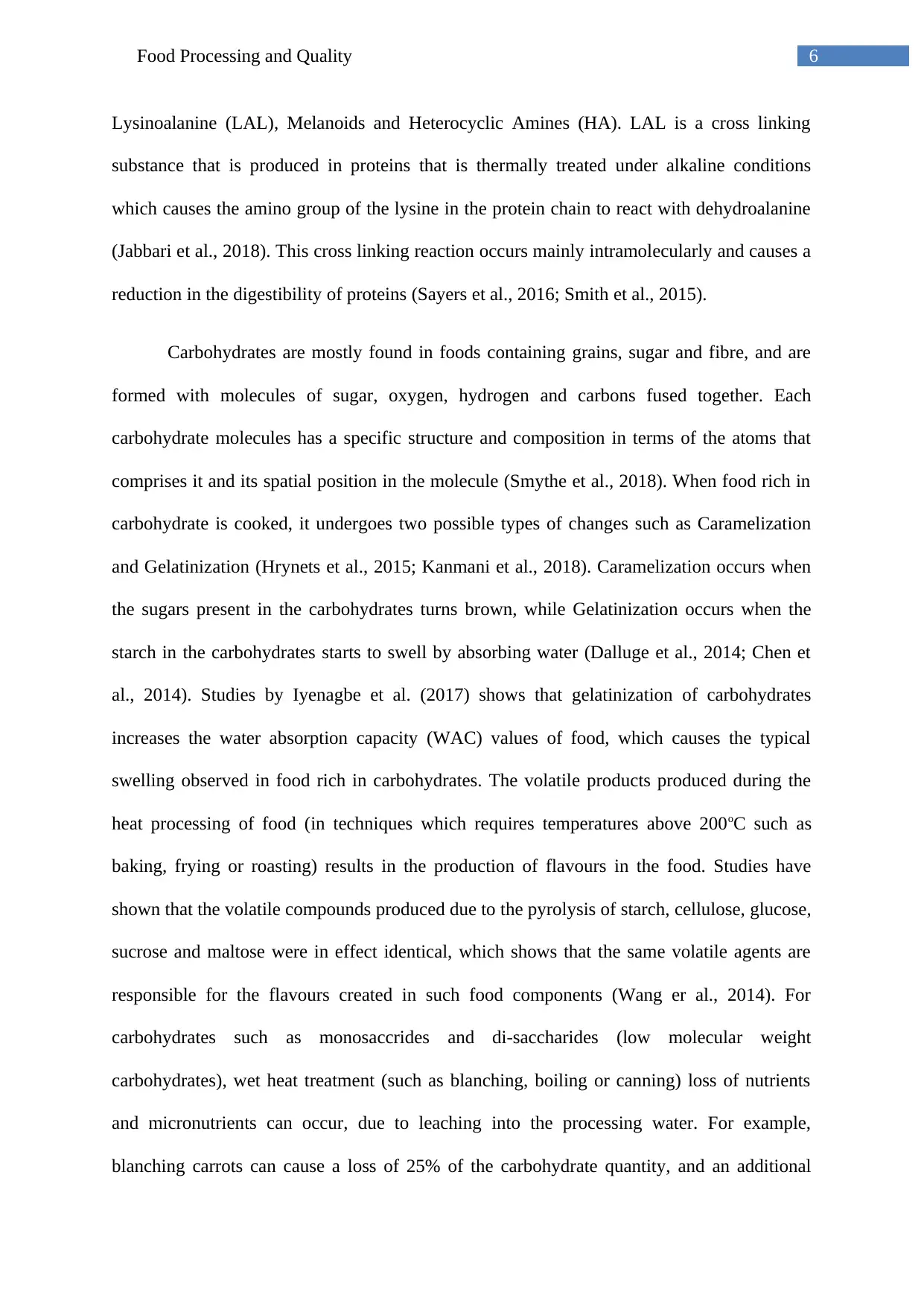
6Food Processing and Quality
Lysinoalanine (LAL), Melanoids and Heterocyclic Amines (HA). LAL is a cross linking
substance that is produced in proteins that is thermally treated under alkaline conditions
which causes the amino group of the lysine in the protein chain to react with dehydroalanine
(Jabbari et al., 2018). This cross linking reaction occurs mainly intramolecularly and causes a
reduction in the digestibility of proteins (Sayers et al., 2016; Smith et al., 2015).
Carbohydrates are mostly found in foods containing grains, sugar and fibre, and are
formed with molecules of sugar, oxygen, hydrogen and carbons fused together. Each
carbohydrate molecules has a specific structure and composition in terms of the atoms that
comprises it and its spatial position in the molecule (Smythe et al., 2018). When food rich in
carbohydrate is cooked, it undergoes two possible types of changes such as Caramelization
and Gelatinization (Hrynets et al., 2015; Kanmani et al., 2018). Caramelization occurs when
the sugars present in the carbohydrates turns brown, while Gelatinization occurs when the
starch in the carbohydrates starts to swell by absorbing water (Dalluge et al., 2014; Chen et
al., 2014). Studies by Iyenagbe et al. (2017) shows that gelatinization of carbohydrates
increases the water absorption capacity (WAC) values of food, which causes the typical
swelling observed in food rich in carbohydrates. The volatile products produced during the
heat processing of food (in techniques which requires temperatures above 200oC such as
baking, frying or roasting) results in the production of flavours in the food. Studies have
shown that the volatile compounds produced due to the pyrolysis of starch, cellulose, glucose,
sucrose and maltose were in effect identical, which shows that the same volatile agents are
responsible for the flavours created in such food components (Wang er al., 2014). For
carbohydrates such as monosaccrides and di-saccharides (low molecular weight
carbohydrates), wet heat treatment (such as blanching, boiling or canning) loss of nutrients
and micronutrients can occur, due to leaching into the processing water. For example,
blanching carrots can cause a loss of 25% of the carbohydrate quantity, and an additional
Lysinoalanine (LAL), Melanoids and Heterocyclic Amines (HA). LAL is a cross linking
substance that is produced in proteins that is thermally treated under alkaline conditions
which causes the amino group of the lysine in the protein chain to react with dehydroalanine
(Jabbari et al., 2018). This cross linking reaction occurs mainly intramolecularly and causes a
reduction in the digestibility of proteins (Sayers et al., 2016; Smith et al., 2015).
Carbohydrates are mostly found in foods containing grains, sugar and fibre, and are
formed with molecules of sugar, oxygen, hydrogen and carbons fused together. Each
carbohydrate molecules has a specific structure and composition in terms of the atoms that
comprises it and its spatial position in the molecule (Smythe et al., 2018). When food rich in
carbohydrate is cooked, it undergoes two possible types of changes such as Caramelization
and Gelatinization (Hrynets et al., 2015; Kanmani et al., 2018). Caramelization occurs when
the sugars present in the carbohydrates turns brown, while Gelatinization occurs when the
starch in the carbohydrates starts to swell by absorbing water (Dalluge et al., 2014; Chen et
al., 2014). Studies by Iyenagbe et al. (2017) shows that gelatinization of carbohydrates
increases the water absorption capacity (WAC) values of food, which causes the typical
swelling observed in food rich in carbohydrates. The volatile products produced during the
heat processing of food (in techniques which requires temperatures above 200oC such as
baking, frying or roasting) results in the production of flavours in the food. Studies have
shown that the volatile compounds produced due to the pyrolysis of starch, cellulose, glucose,
sucrose and maltose were in effect identical, which shows that the same volatile agents are
responsible for the flavours created in such food components (Wang er al., 2014). For
carbohydrates such as monosaccrides and di-saccharides (low molecular weight
carbohydrates), wet heat treatment (such as blanching, boiling or canning) loss of nutrients
and micronutrients can occur, due to leaching into the processing water. For example,
blanching carrots can cause a loss of 25% of the carbohydrate quantity, and an additional
Paraphrase This Document
Need a fresh take? Get an instant paraphrase of this document with our AI Paraphraser

7Food Processing and Quality
20% loss can be caused by boiling (Stahl, 2014). This loss is however lesser in case of green
beans, peas and sprouts. Boiling also causes a loss in fructose and glucose as well as sucrose
(however it is lesser than glucose and fructose loss). The loss of carbohydrates is also
affected by the period of storage of the food before processing as well as on its cultivation
and harvesting, with more losses of carbohydrates occurring in food that is stored for a longer
period of time before being processed (Deng et al., 2015).
The heat causes the weak bonds and glycosidic linkages in polysaccharide chains to
be broken. This causes the depolymerisation of the carbohydrate molecules and improves the
solubility of the compounds (Price et al., 2015). Extensive depolymerisation can cause the
formation of alcohol soluble fragments and significantly reduced quantity of dietary fibres;
while moderate depolymerisation can slightly affect the dietary fibre content, but can
significant affect the physiological and functional properties of the food. The dietary fibre
content is also affected by the leakage of nutrients into the processing water, production of
the intermediates of Millard Reaction which causes an increase in the lignin content and the
formation of resistant starch (Pold et al., 2016). Thermal processing also changes the
architecture of the cell wall which also affects the nutritional and sensory characteristics of
the food. The cell wall matrix changes as a result of heat treatment, that causes structural
changes and affects the cross linkages between the phenolics and polysaccharides in the cell
wall. For wheat flour, this can increase the solubility of the dietary fibre, which is also
dependant on the net water content (lower water content allowing higher solubility of the
fibre) (Ye et al., 2015; Fuller et al., 2016).
Studies have shown that after heat treatment, the free fraction in phenolics acids
increased in the food product, while the amounts of glycoside, ester and ester bound
compounds as well as the total flavanone glycosides decreased. It also resulted in the
increased in the antioxidant activity and the total antioxidant capacity. Also, prolonged
20% loss can be caused by boiling (Stahl, 2014). This loss is however lesser in case of green
beans, peas and sprouts. Boiling also causes a loss in fructose and glucose as well as sucrose
(however it is lesser than glucose and fructose loss). The loss of carbohydrates is also
affected by the period of storage of the food before processing as well as on its cultivation
and harvesting, with more losses of carbohydrates occurring in food that is stored for a longer
period of time before being processed (Deng et al., 2015).
The heat causes the weak bonds and glycosidic linkages in polysaccharide chains to
be broken. This causes the depolymerisation of the carbohydrate molecules and improves the
solubility of the compounds (Price et al., 2015). Extensive depolymerisation can cause the
formation of alcohol soluble fragments and significantly reduced quantity of dietary fibres;
while moderate depolymerisation can slightly affect the dietary fibre content, but can
significant affect the physiological and functional properties of the food. The dietary fibre
content is also affected by the leakage of nutrients into the processing water, production of
the intermediates of Millard Reaction which causes an increase in the lignin content and the
formation of resistant starch (Pold et al., 2016). Thermal processing also changes the
architecture of the cell wall which also affects the nutritional and sensory characteristics of
the food. The cell wall matrix changes as a result of heat treatment, that causes structural
changes and affects the cross linkages between the phenolics and polysaccharides in the cell
wall. For wheat flour, this can increase the solubility of the dietary fibre, which is also
dependant on the net water content (lower water content allowing higher solubility of the
fibre) (Ye et al., 2015; Fuller et al., 2016).
Studies have shown that after heat treatment, the free fraction in phenolics acids
increased in the food product, while the amounts of glycoside, ester and ester bound
compounds as well as the total flavanone glycosides decreased. It also resulted in the
increased in the antioxidant activity and the total antioxidant capacity. Also, prolonged
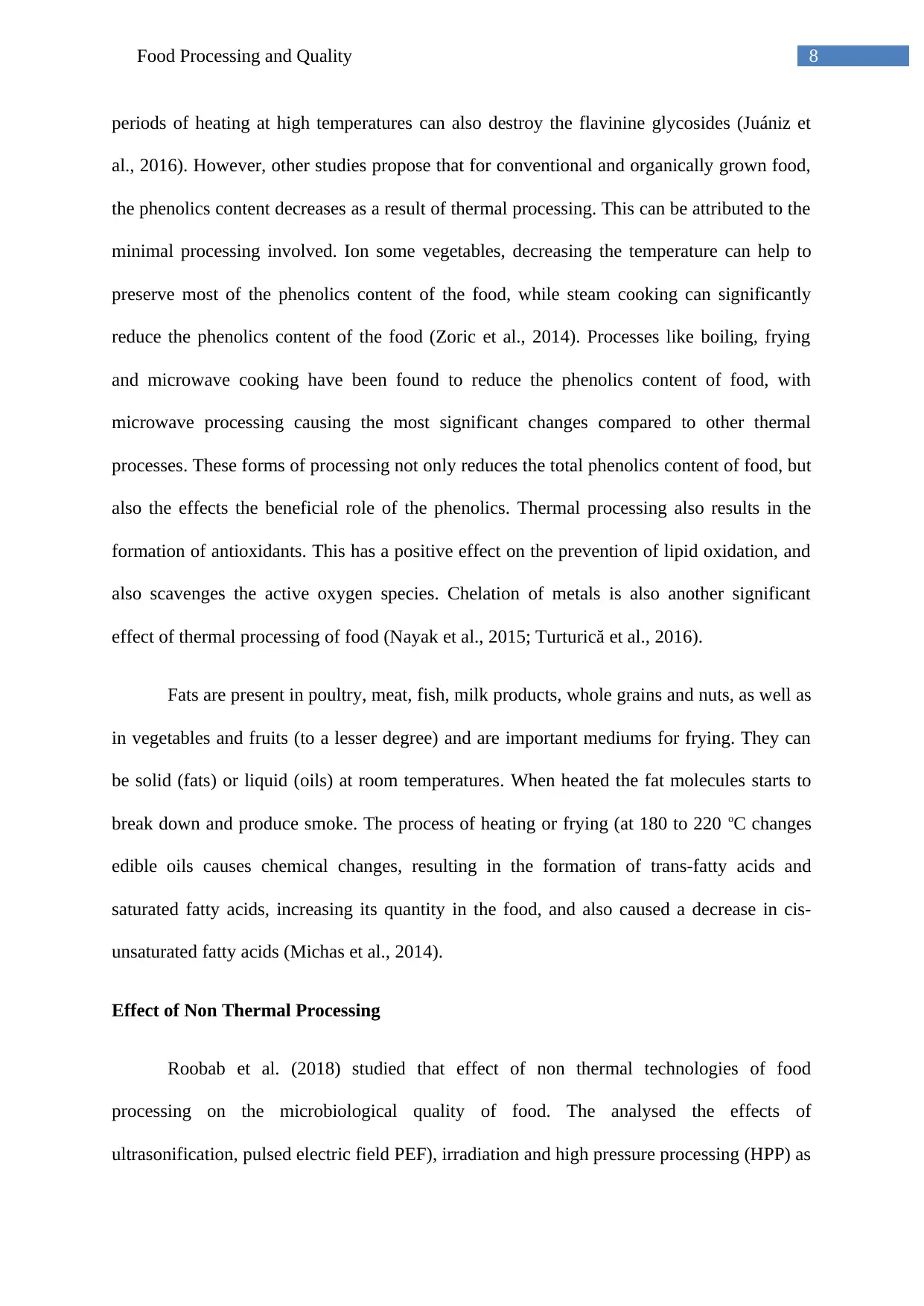
8Food Processing and Quality
periods of heating at high temperatures can also destroy the flavinine glycosides (Juániz et
al., 2016). However, other studies propose that for conventional and organically grown food,
the phenolics content decreases as a result of thermal processing. This can be attributed to the
minimal processing involved. Ion some vegetables, decreasing the temperature can help to
preserve most of the phenolics content of the food, while steam cooking can significantly
reduce the phenolics content of the food (Zoric et al., 2014). Processes like boiling, frying
and microwave cooking have been found to reduce the phenolics content of food, with
microwave processing causing the most significant changes compared to other thermal
processes. These forms of processing not only reduces the total phenolics content of food, but
also the effects the beneficial role of the phenolics. Thermal processing also results in the
formation of antioxidants. This has a positive effect on the prevention of lipid oxidation, and
also scavenges the active oxygen species. Chelation of metals is also another significant
effect of thermal processing of food (Nayak et al., 2015; Turturică et al., 2016).
Fats are present in poultry, meat, fish, milk products, whole grains and nuts, as well as
in vegetables and fruits (to a lesser degree) and are important mediums for frying. They can
be solid (fats) or liquid (oils) at room temperatures. When heated the fat molecules starts to
break down and produce smoke. The process of heating or frying (at 180 to 220 oC changes
edible oils causes chemical changes, resulting in the formation of trans-fatty acids and
saturated fatty acids, increasing its quantity in the food, and also caused a decrease in cis-
unsaturated fatty acids (Michas et al., 2014).
Effect of Non Thermal Processing
Roobab et al. (2018) studied that effect of non thermal technologies of food
processing on the microbiological quality of food. The analysed the effects of
ultrasonification, pulsed electric field PEF), irradiation and high pressure processing (HPP) as
periods of heating at high temperatures can also destroy the flavinine glycosides (Juániz et
al., 2016). However, other studies propose that for conventional and organically grown food,
the phenolics content decreases as a result of thermal processing. This can be attributed to the
minimal processing involved. Ion some vegetables, decreasing the temperature can help to
preserve most of the phenolics content of the food, while steam cooking can significantly
reduce the phenolics content of the food (Zoric et al., 2014). Processes like boiling, frying
and microwave cooking have been found to reduce the phenolics content of food, with
microwave processing causing the most significant changes compared to other thermal
processes. These forms of processing not only reduces the total phenolics content of food, but
also the effects the beneficial role of the phenolics. Thermal processing also results in the
formation of antioxidants. This has a positive effect on the prevention of lipid oxidation, and
also scavenges the active oxygen species. Chelation of metals is also another significant
effect of thermal processing of food (Nayak et al., 2015; Turturică et al., 2016).
Fats are present in poultry, meat, fish, milk products, whole grains and nuts, as well as
in vegetables and fruits (to a lesser degree) and are important mediums for frying. They can
be solid (fats) or liquid (oils) at room temperatures. When heated the fat molecules starts to
break down and produce smoke. The process of heating or frying (at 180 to 220 oC changes
edible oils causes chemical changes, resulting in the formation of trans-fatty acids and
saturated fatty acids, increasing its quantity in the food, and also caused a decrease in cis-
unsaturated fatty acids (Michas et al., 2014).
Effect of Non Thermal Processing
Roobab et al. (2018) studied that effect of non thermal technologies of food
processing on the microbiological quality of food. The analysed the effects of
ultrasonification, pulsed electric field PEF), irradiation and high pressure processing (HPP) as
⊘ This is a preview!⊘
Do you want full access?
Subscribe today to unlock all pages.

Trusted by 1+ million students worldwide
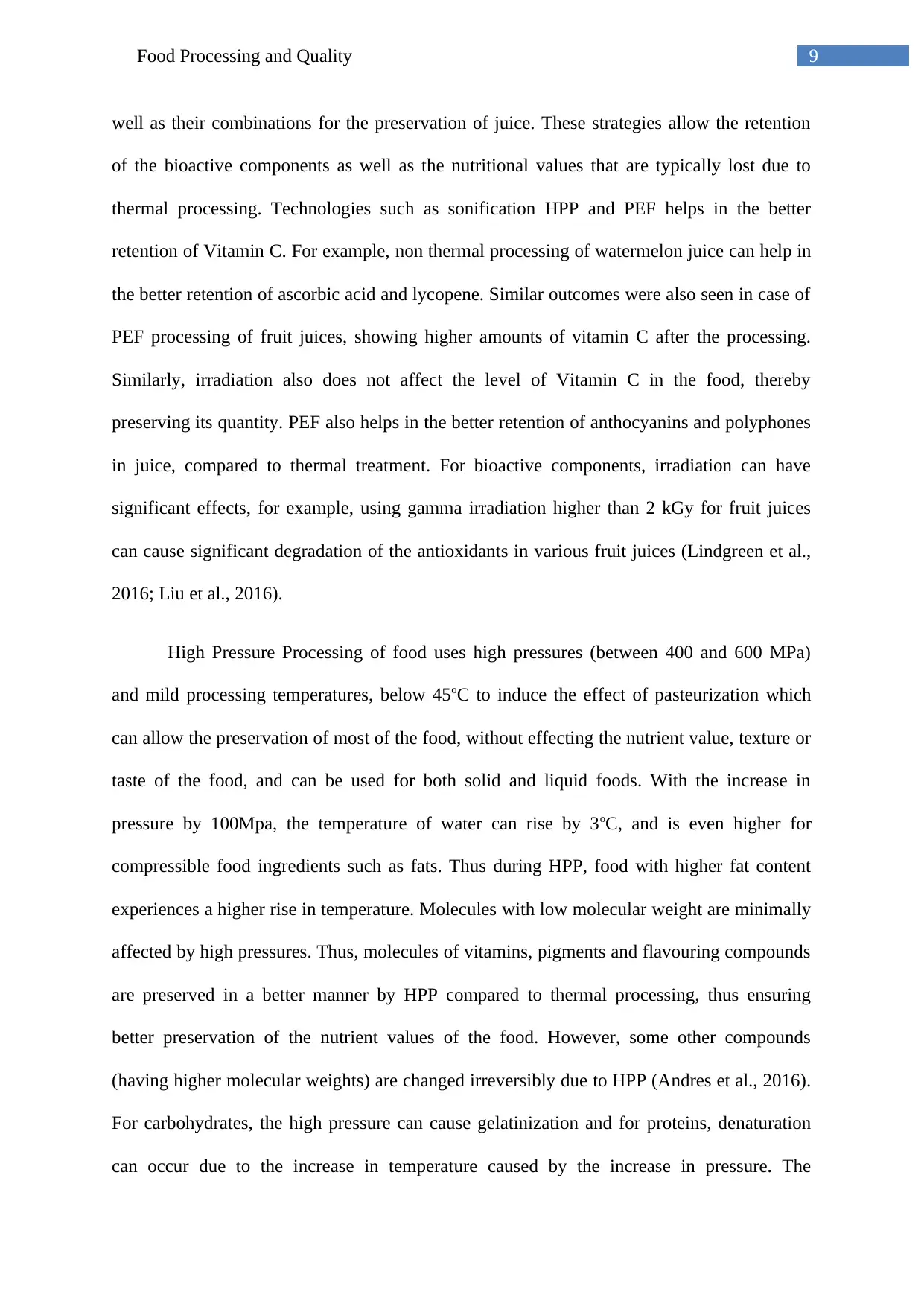
9Food Processing and Quality
well as their combinations for the preservation of juice. These strategies allow the retention
of the bioactive components as well as the nutritional values that are typically lost due to
thermal processing. Technologies such as sonification HPP and PEF helps in the better
retention of Vitamin C. For example, non thermal processing of watermelon juice can help in
the better retention of ascorbic acid and lycopene. Similar outcomes were also seen in case of
PEF processing of fruit juices, showing higher amounts of vitamin C after the processing.
Similarly, irradiation also does not affect the level of Vitamin C in the food, thereby
preserving its quantity. PEF also helps in the better retention of anthocyanins and polyphones
in juice, compared to thermal treatment. For bioactive components, irradiation can have
significant effects, for example, using gamma irradiation higher than 2 kGy for fruit juices
can cause significant degradation of the antioxidants in various fruit juices (Lindgreen et al.,
2016; Liu et al., 2016).
High Pressure Processing of food uses high pressures (between 400 and 600 MPa)
and mild processing temperatures, below 45oC to induce the effect of pasteurization which
can allow the preservation of most of the food, without effecting the nutrient value, texture or
taste of the food, and can be used for both solid and liquid foods. With the increase in
pressure by 100Mpa, the temperature of water can rise by 3oC, and is even higher for
compressible food ingredients such as fats. Thus during HPP, food with higher fat content
experiences a higher rise in temperature. Molecules with low molecular weight are minimally
affected by high pressures. Thus, molecules of vitamins, pigments and flavouring compounds
are preserved in a better manner by HPP compared to thermal processing, thus ensuring
better preservation of the nutrient values of the food. However, some other compounds
(having higher molecular weights) are changed irreversibly due to HPP (Andres et al., 2016).
For carbohydrates, the high pressure can cause gelatinization and for proteins, denaturation
can occur due to the increase in temperature caused by the increase in pressure. The
well as their combinations for the preservation of juice. These strategies allow the retention
of the bioactive components as well as the nutritional values that are typically lost due to
thermal processing. Technologies such as sonification HPP and PEF helps in the better
retention of Vitamin C. For example, non thermal processing of watermelon juice can help in
the better retention of ascorbic acid and lycopene. Similar outcomes were also seen in case of
PEF processing of fruit juices, showing higher amounts of vitamin C after the processing.
Similarly, irradiation also does not affect the level of Vitamin C in the food, thereby
preserving its quantity. PEF also helps in the better retention of anthocyanins and polyphones
in juice, compared to thermal treatment. For bioactive components, irradiation can have
significant effects, for example, using gamma irradiation higher than 2 kGy for fruit juices
can cause significant degradation of the antioxidants in various fruit juices (Lindgreen et al.,
2016; Liu et al., 2016).
High Pressure Processing of food uses high pressures (between 400 and 600 MPa)
and mild processing temperatures, below 45oC to induce the effect of pasteurization which
can allow the preservation of most of the food, without effecting the nutrient value, texture or
taste of the food, and can be used for both solid and liquid foods. With the increase in
pressure by 100Mpa, the temperature of water can rise by 3oC, and is even higher for
compressible food ingredients such as fats. Thus during HPP, food with higher fat content
experiences a higher rise in temperature. Molecules with low molecular weight are minimally
affected by high pressures. Thus, molecules of vitamins, pigments and flavouring compounds
are preserved in a better manner by HPP compared to thermal processing, thus ensuring
better preservation of the nutrient values of the food. However, some other compounds
(having higher molecular weights) are changed irreversibly due to HPP (Andres et al., 2016).
For carbohydrates, the high pressure can cause gelatinization and for proteins, denaturation
can occur due to the increase in temperature caused by the increase in pressure. The
Paraphrase This Document
Need a fresh take? Get an instant paraphrase of this document with our AI Paraphraser
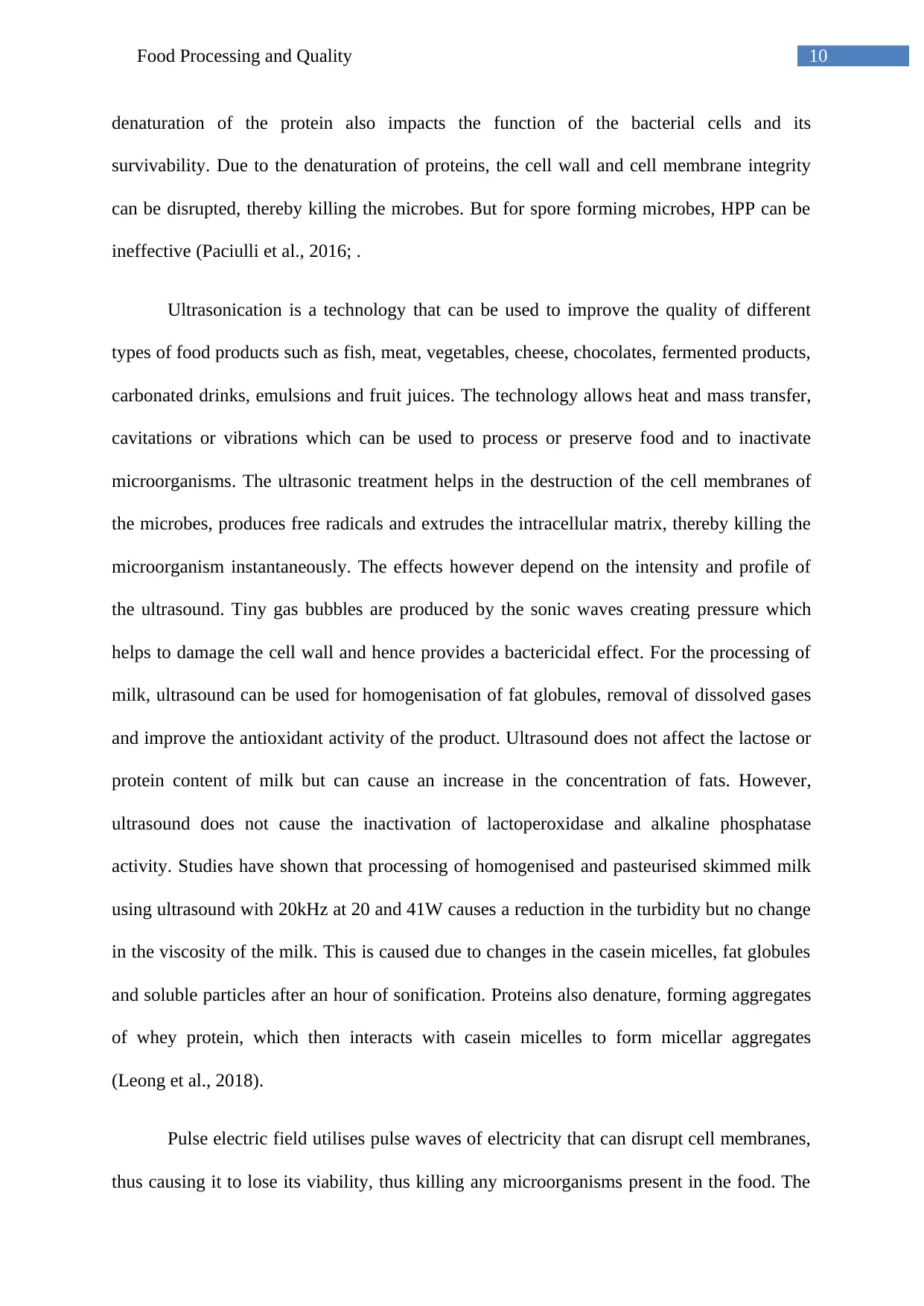
10Food Processing and Quality
denaturation of the protein also impacts the function of the bacterial cells and its
survivability. Due to the denaturation of proteins, the cell wall and cell membrane integrity
can be disrupted, thereby killing the microbes. But for spore forming microbes, HPP can be
ineffective (Paciulli et al., 2016; .
Ultrasonication is a technology that can be used to improve the quality of different
types of food products such as fish, meat, vegetables, cheese, chocolates, fermented products,
carbonated drinks, emulsions and fruit juices. The technology allows heat and mass transfer,
cavitations or vibrations which can be used to process or preserve food and to inactivate
microorganisms. The ultrasonic treatment helps in the destruction of the cell membranes of
the microbes, produces free radicals and extrudes the intracellular matrix, thereby killing the
microorganism instantaneously. The effects however depend on the intensity and profile of
the ultrasound. Tiny gas bubbles are produced by the sonic waves creating pressure which
helps to damage the cell wall and hence provides a bactericidal effect. For the processing of
milk, ultrasound can be used for homogenisation of fat globules, removal of dissolved gases
and improve the antioxidant activity of the product. Ultrasound does not affect the lactose or
protein content of milk but can cause an increase in the concentration of fats. However,
ultrasound does not cause the inactivation of lactoperoxidase and alkaline phosphatase
activity. Studies have shown that processing of homogenised and pasteurised skimmed milk
using ultrasound with 20kHz at 20 and 41W causes a reduction in the turbidity but no change
in the viscosity of the milk. This is caused due to changes in the casein micelles, fat globules
and soluble particles after an hour of sonification. Proteins also denature, forming aggregates
of whey protein, which then interacts with casein micelles to form micellar aggregates
(Leong et al., 2018).
Pulse electric field utilises pulse waves of electricity that can disrupt cell membranes,
thus causing it to lose its viability, thus killing any microorganisms present in the food. The
denaturation of the protein also impacts the function of the bacterial cells and its
survivability. Due to the denaturation of proteins, the cell wall and cell membrane integrity
can be disrupted, thereby killing the microbes. But for spore forming microbes, HPP can be
ineffective (Paciulli et al., 2016; .
Ultrasonication is a technology that can be used to improve the quality of different
types of food products such as fish, meat, vegetables, cheese, chocolates, fermented products,
carbonated drinks, emulsions and fruit juices. The technology allows heat and mass transfer,
cavitations or vibrations which can be used to process or preserve food and to inactivate
microorganisms. The ultrasonic treatment helps in the destruction of the cell membranes of
the microbes, produces free radicals and extrudes the intracellular matrix, thereby killing the
microorganism instantaneously. The effects however depend on the intensity and profile of
the ultrasound. Tiny gas bubbles are produced by the sonic waves creating pressure which
helps to damage the cell wall and hence provides a bactericidal effect. For the processing of
milk, ultrasound can be used for homogenisation of fat globules, removal of dissolved gases
and improve the antioxidant activity of the product. Ultrasound does not affect the lactose or
protein content of milk but can cause an increase in the concentration of fats. However,
ultrasound does not cause the inactivation of lactoperoxidase and alkaline phosphatase
activity. Studies have shown that processing of homogenised and pasteurised skimmed milk
using ultrasound with 20kHz at 20 and 41W causes a reduction in the turbidity but no change
in the viscosity of the milk. This is caused due to changes in the casein micelles, fat globules
and soluble particles after an hour of sonification. Proteins also denature, forming aggregates
of whey protein, which then interacts with casein micelles to form micellar aggregates
(Leong et al., 2018).
Pulse electric field utilises pulse waves of electricity that can disrupt cell membranes,
thus causing it to lose its viability, thus killing any microorganisms present in the food. The
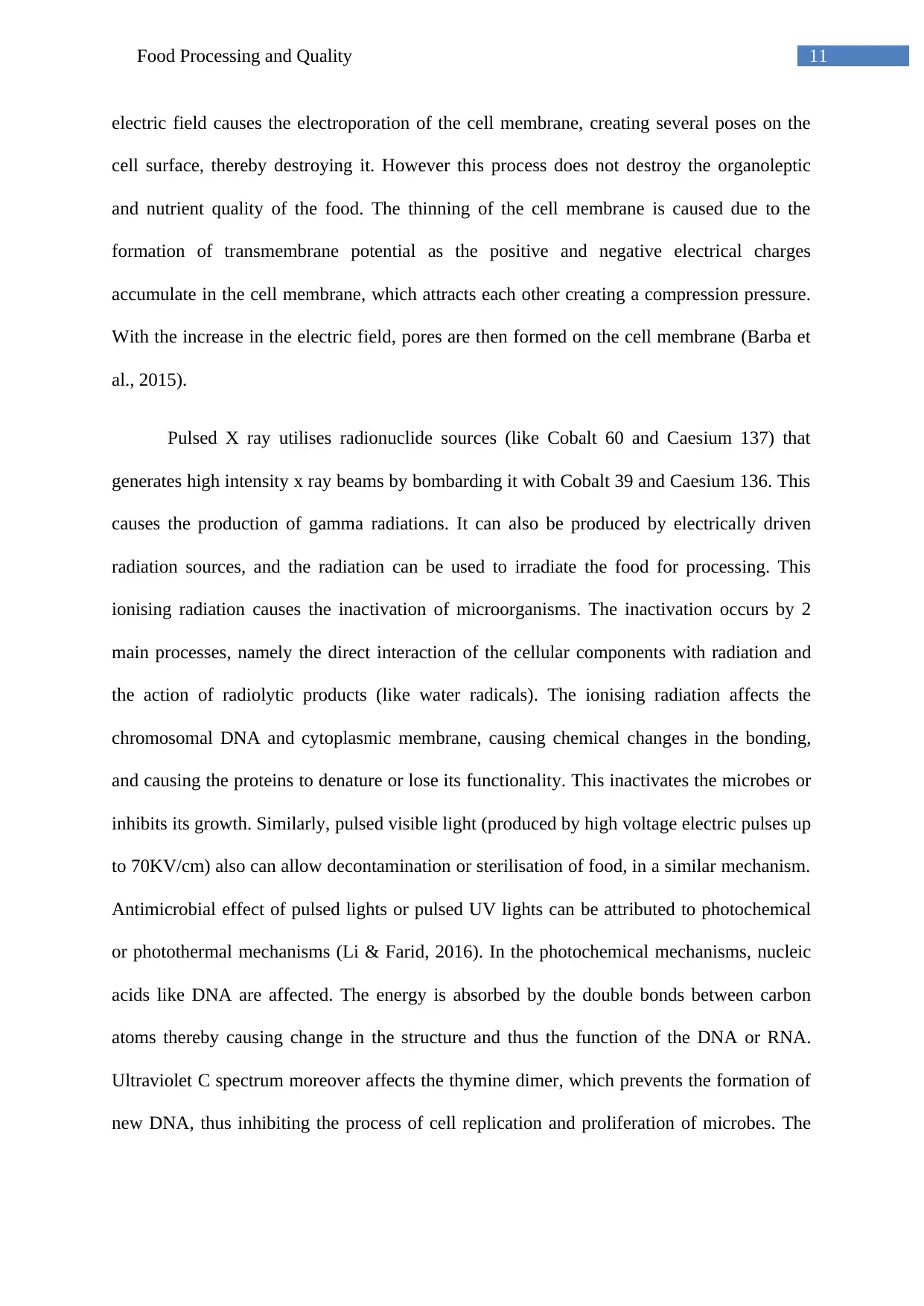
11Food Processing and Quality
electric field causes the electroporation of the cell membrane, creating several poses on the
cell surface, thereby destroying it. However this process does not destroy the organoleptic
and nutrient quality of the food. The thinning of the cell membrane is caused due to the
formation of transmembrane potential as the positive and negative electrical charges
accumulate in the cell membrane, which attracts each other creating a compression pressure.
With the increase in the electric field, pores are then formed on the cell membrane (Barba et
al., 2015).
Pulsed X ray utilises radionuclide sources (like Cobalt 60 and Caesium 137) that
generates high intensity x ray beams by bombarding it with Cobalt 39 and Caesium 136. This
causes the production of gamma radiations. It can also be produced by electrically driven
radiation sources, and the radiation can be used to irradiate the food for processing. This
ionising radiation causes the inactivation of microorganisms. The inactivation occurs by 2
main processes, namely the direct interaction of the cellular components with radiation and
the action of radiolytic products (like water radicals). The ionising radiation affects the
chromosomal DNA and cytoplasmic membrane, causing chemical changes in the bonding,
and causing the proteins to denature or lose its functionality. This inactivates the microbes or
inhibits its growth. Similarly, pulsed visible light (produced by high voltage electric pulses up
to 70KV/cm) also can allow decontamination or sterilisation of food, in a similar mechanism.
Antimicrobial effect of pulsed lights or pulsed UV lights can be attributed to photochemical
or photothermal mechanisms (Li & Farid, 2016). In the photochemical mechanisms, nucleic
acids like DNA are affected. The energy is absorbed by the double bonds between carbon
atoms thereby causing change in the structure and thus the function of the DNA or RNA.
Ultraviolet C spectrum moreover affects the thymine dimer, which prevents the formation of
new DNA, thus inhibiting the process of cell replication and proliferation of microbes. The
electric field causes the electroporation of the cell membrane, creating several poses on the
cell surface, thereby destroying it. However this process does not destroy the organoleptic
and nutrient quality of the food. The thinning of the cell membrane is caused due to the
formation of transmembrane potential as the positive and negative electrical charges
accumulate in the cell membrane, which attracts each other creating a compression pressure.
With the increase in the electric field, pores are then formed on the cell membrane (Barba et
al., 2015).
Pulsed X ray utilises radionuclide sources (like Cobalt 60 and Caesium 137) that
generates high intensity x ray beams by bombarding it with Cobalt 39 and Caesium 136. This
causes the production of gamma radiations. It can also be produced by electrically driven
radiation sources, and the radiation can be used to irradiate the food for processing. This
ionising radiation causes the inactivation of microorganisms. The inactivation occurs by 2
main processes, namely the direct interaction of the cellular components with radiation and
the action of radiolytic products (like water radicals). The ionising radiation affects the
chromosomal DNA and cytoplasmic membrane, causing chemical changes in the bonding,
and causing the proteins to denature or lose its functionality. This inactivates the microbes or
inhibits its growth. Similarly, pulsed visible light (produced by high voltage electric pulses up
to 70KV/cm) also can allow decontamination or sterilisation of food, in a similar mechanism.
Antimicrobial effect of pulsed lights or pulsed UV lights can be attributed to photochemical
or photothermal mechanisms (Li & Farid, 2016). In the photochemical mechanisms, nucleic
acids like DNA are affected. The energy is absorbed by the double bonds between carbon
atoms thereby causing change in the structure and thus the function of the DNA or RNA.
Ultraviolet C spectrum moreover affects the thymine dimer, which prevents the formation of
new DNA, thus inhibiting the process of cell replication and proliferation of microbes. The
⊘ This is a preview!⊘
Do you want full access?
Subscribe today to unlock all pages.

Trusted by 1+ million students worldwide
1 out of 30
Related Documents
Your All-in-One AI-Powered Toolkit for Academic Success.
+13062052269
info@desklib.com
Available 24*7 on WhatsApp / Email
![[object Object]](/_next/static/media/star-bottom.7253800d.svg)
Unlock your academic potential
Copyright © 2020–2025 A2Z Services. All Rights Reserved. Developed and managed by ZUCOL.




